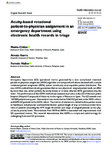Mostrar el registro sencillo del ítem
Acuity-based rotational patient-to-physician assignment in an emergency department using electronic health records in triage
| dc.creator | Cildoz Esquíroz, Marta | es_ES |
| dc.creator | Ibarra Bolt, Amaya | es_ES |
| dc.creator | Mallor Giménez, Fermín | es_ES |
| dc.date.accessioned | 2023-08-22T18:08:46Z | |
| dc.date.available | 2023-08-22T18:08:46Z | |
| dc.date.issued | 2023 | |
| dc.identifier.citation | Cildoz, M., Ibarra, A.,, Mallor, F. (2023) Acuity-based rotational patient-to-physician assignment in an emergency department using electronic health records in triage. Health Informatics Journal, 29(2), 1-15. https://doi.org/10.1177/14604582231167430. | en |
| dc.identifier.issn | 1460-4582 | |
| dc.identifier.uri | https://hdl.handle.net/2454/45990 | |
| dc.description.abstract | Emergency department (ED) operational metrics generated by a new acuity-based rotational patient-to-physician assignment (ARPA) algorithm are compared with those obtained with a simple rotational patient assignment (SRPA) system aimed only at an equitable patient distribution. The new ARPA method theoretically guarantees that no two physicians’ assigned patient loads can differ by more than one, either partially (by acuity levels) or in total; whereas SRPA guarantees only the latter. The performance of the ARPA method was assessed in practice in the ED of the main public hospital (Hospital Compound of Navarra) in the region of Navarre in Spain. This ED attends over 140 000 patients every year. Data analysis was conducted on 9,063 ED patients in the SRPA cohort, and 8,892 ED patients in the ARPA cohort. The metrics of interest are related both to patient access to healthcare and physician workload distribution: patient length of stay; arrival-to-provider time; ratio of patients exceeding the APT target threshold; and range of assigned patients across physicians by priority levels. The transition from SRPA to ARPA is associated with improvements in all ED operational metrics. This research demonstrates that ARPA is a simple and useful strategy for redesigning front-end ED processes. | en |
| dc.description.sponsorship | This work was supported by the Ministerio de Ciencia e Innovación (MTM2016-77015-R (AEI, Spain, FEDER UE)) and Ministerio de Ciencia e Innovación (PID2020-114031RB-I00 (AEI, FEDER EU)). | en |
| dc.format.mimetype | application/pdf | en |
| dc.language.iso | eng | en |
| dc.publisher | SAGE | en |
| dc.relation.ispartof | Health Informatics Journal, 29(2), 2023 | en |
| dc.rights | © The Author(s) 2023. Creative Commons Non Commercial CC BY-NC: This article is distributed under the terms of theCreative Commons Attribution-NonCommercial 4.0 License. | en |
| dc.rights.uri | http://creativecommons.org/licenses/by-nc/4.0/ | |
| dc.subject | ED front-end | en |
| dc.subject | Emergency department | en |
| dc.subject | Patient assignment | en |
| dc.subject | Patient flow | en |
| dc.subject | Workload balancing | en |
| dc.title | Acuity-based rotational patient-to-physician assignment in an emergency department using electronic health records in triage | en |
| dc.type | Artículo / Artikulua | es |
| dc.type | info:eu-repo/semantics/article | en |
| dc.date.updated | 2023-08-22T18:00:42Z | |
| dc.contributor.department | Estadística, Informática y Matemáticas | es_ES |
| dc.contributor.department | Estatistika, Informatika eta Matematika | eu |
| dc.contributor.department | Institute of Smart Cities - ISC | en |
| dc.rights.accessRights | Acceso abierto / Sarbide irekia | es |
| dc.rights.accessRights | info:eu-repo/semantics/openAccess | en |
| dc.identifier.doi | 10.1177/14604582231167430 | |
| dc.relation.projectID | info:eu-repo/grantAgreement/AEI//MTM2016-77015-R | en |
| dc.relation.projectID | info:eu-repo/grantAgreement/AEI/Plan Estatal de Investigación Científica y Técnica y de Innovación 2017-2020/PID2020-114031RB-I00/ES/ | en |
| dc.relation.publisherversion | https://doi.org/10.1177/14604582231167430 | |
| dc.type.version | Versión publicada / Argitaratu den bertsioa | es |
| dc.type.version | info:eu-repo/semantics/publishedVersion | en |



